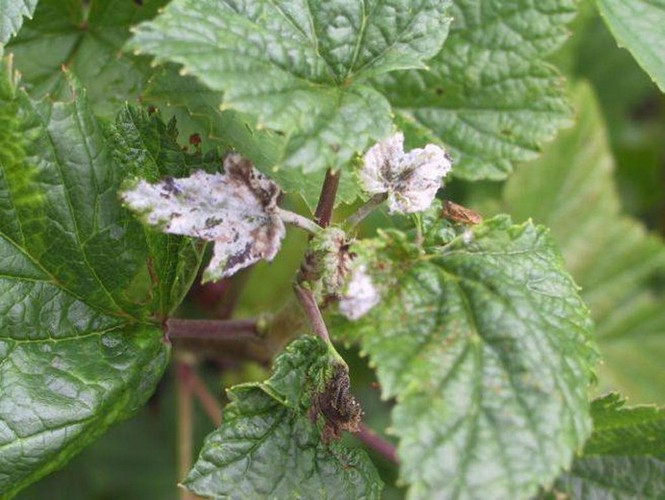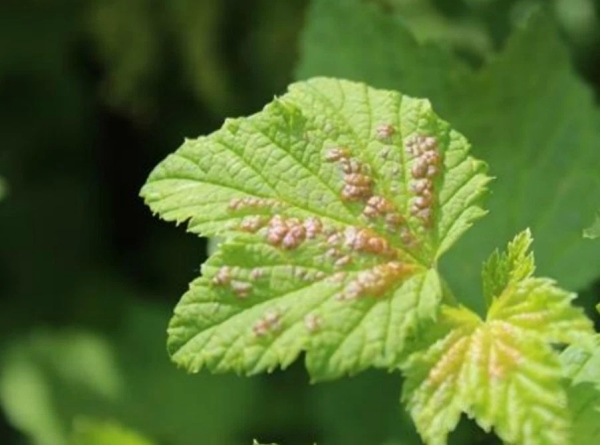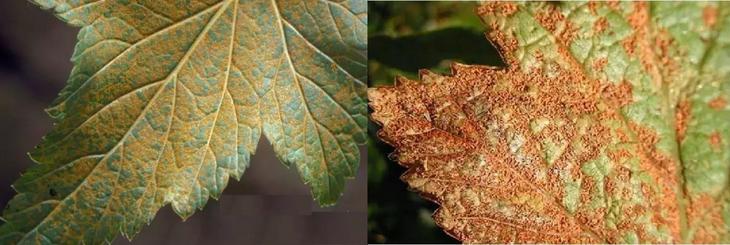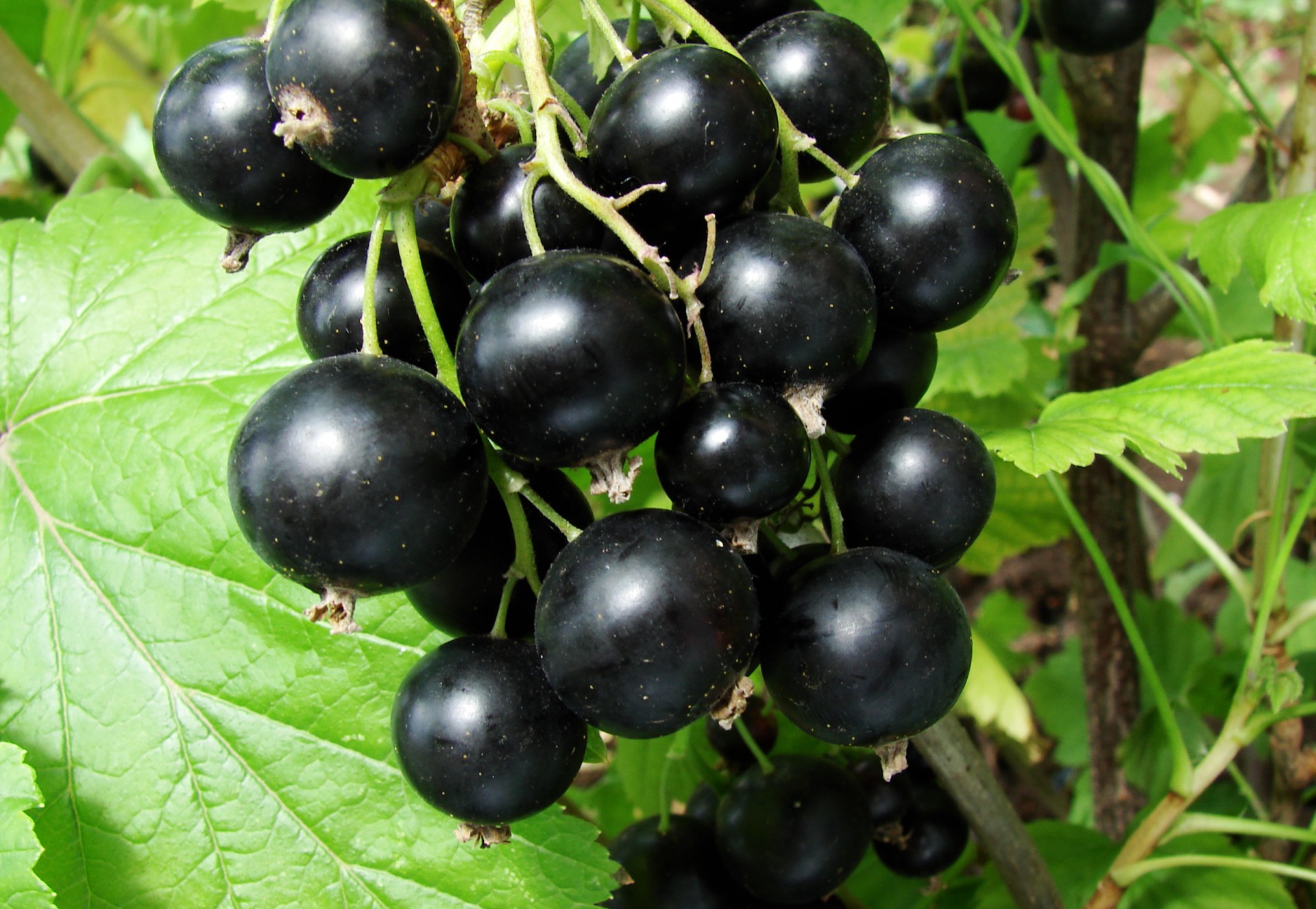Content:
Black currant is very popular among summer residents in central Russia. The plant tolerates cold winters well and adapts to unstable summer weather, so even a beginner can easily cope with the cultivation of this crop. However, if the rules of care are not followed, black currant diseases often occur, which completely destroy the plant or deprive the crop.
This article describes in detail currant diseases and the fight against them.
Powdery mildew
Description
A fungal disease that appears on young shoots and leaves in May, grows throughout the summer, hibernates in fallen leaves. As a result, the currants stop growing, the leaves dry out, their tips twist, and the berries do not ripen and fall off. In the absence of timely treatment, the disease progresses within 6 years and completely destroys large groups of bushes. The appearance is a powdery white bloom, which over time becomes dark and grows tightly to the bush, takes away strength from it and sucks out nutrients. The fungus occurs at high air humidity and prolonged high temperatures, as well as in soil oversaturated with nitrogen fertilizers. Spores are spread by insects, dewdrops and wind.
Treatment
Fresh plaque can be washed off with soapy water. This method can be used if the disease has just appeared, and the lesion is of a single focal character. In case of massive damage to the branches, they need to be cut and burned, and the bushes should be sprayed with Fundazol, Fitosporin or other fungicides. In case of group infection of bushes, 4 treatments need to be carried out: before and after flowering, after harvesting and 14 days after 3 sprays. As a preventive measure, it is worth removing fallen leaves at the end of the summer season and burning them.
Anthracnose
Description
In mid-summer, spots of red, brown or black may appear on the currant leaf, which gradually swell and deform the leaves. This fungal infection is called anthracnose. High humidity is the main factor in the occurrence of this disease, which, first of all, affects young branches and reduces the frost resistance of the shrub. The fungus hibernates in fallen leaves, so it can be found on the back of the leaves located on the lower branches.
Treatment
You can cure the disease with the help of Bordeaux liquid: you need to thoroughly spray all the bushes when the first signs of infection are detected and after removing the berries. As a preventive measure, it is recommended to avoid planting a young bush in the place where the affected specimen grew, and also to burn all the fallen leaves on the site.
Rust
This disease can occur in two forms:
- Columnar rust covers the leaf with bright red oblong spots. Spores of the fungus appear on conifers and are carried by the wind. The peak of reproduction is in July, when the fungi begin to multiply on the leaves, forming columnar growths;
- Goblet rust appears on the back of the leaf as pale or bright orange spots.The defeat occurs by air, spores appear on last year's sedge and are carried by the wind in the spring. By the beginning of June, the spore ripening phase begins, depressions appear on the lower part of the leaves.
How to treat rust-affected currants:
- Four times fungicidal treatment with an interval of 1.5 weeks. The first spraying is carried out before the active growth of leaves begins. The drug Previkur and Bordeaux mixture is highly effective;
- The folk method of combating the disease is spraying with a garlic-tobacco solution. A mixture of 1 cup of garlic cloves, 200 g of tobacco dust and 2 liters of water to insist for 3 days. Then add soapy water and a pinch of hot pepper. With the resulting solution, process the bare branches before blooming the sheets;
- Preventive measures: complete destruction of infected branches, mowing and disposal of sedge in the area adjacent to the garden, autumn harvesting of dry grass and leaves, selection of disease-resistant varieties.
Septoriasis
This is the most common disease of black currant, appears in conditions of high humidity on heavily thickened bushes.
Symptoms
The leaves are densely covered with gray dots, framed by a thick dark brown border. When the spores mature, convex round growths appear. This fungus also affects the berries, so the disease destroys the crop, the bush dries out.
Treatment
- Copper sulfate treatment at intervals of 1 time per 2 weeks. The procedure must be carried out three times, the first - after the foliage has completely bloomed;
- Destruction of infected plant parts;
- Thinning branches to avoid excessive thickening of the bush;
- A preventive measure of control is digging up the earth around the bushes, harvesting grass and leaves.
Terry
Description
Terry is a viral disease that completely destroys the bush. To date, it is not known how to treat currants for viral diseases. The causative agent is a kidney mite. On the infected bush, ugly inflorescences appear that do not yield a crop. Then the branches begin to ache, this is expressed in the fact that they become thin. The infection gradually takes over the entire plant, begins to rot, and as a result, the currant dies. After which it remains to dig up and destroy. Preventive measures can be taken to avoid currant diseases. First of all, this is the protection of the bush from the tick. The treatment of bushes should be carried out only with sterile tools, since the virus hibernates in the tissues of a diseased bush, and is not spread by wind or rain.
Striped mosaic
If the veins of the leaf turn yellow, and their number is growing all the time, then this is a sign of infection with a viral disease. Fighting with striped mosaics is useless, just like with terry. The virus is spread by insects and remains in the tissues of the bush. Therefore, the only measure is to burn the bush. The soil at the site of the affected plant can be treated with a solution of potassium permanganate.
Nectric drying of the shoot, marginal necrosis, gray rot are also common diseases of black currant, the fight against them consists in treating the bushes with fungicides, cleaning the area from grass and leaves and destroying diseased branches.
Pests
In addition to diseases, there are also currant pests that destroy the crop or completely destroy the bush.
Kidney mite
Characteristic
A very small insect 0.3 mm long that settles in the buds of a plant and lays eggs there. Each kidney can hide a thousandth colony. The kidney grows to an unnatural size. Since the bud mite feeds on plant sap, the buds quickly dry out and fall off. Therefore, the yield of the bush is greatly reduced. Also, the tick is the causative agent of viral terry, which completely degenerates the bush.In view of the small size of this insect, it is almost impossible to make a photo, but by the appearance of the kidney, you can accurately determine the presence of this pest.
Control measures
- Removing infected buds or whole branches;
- Pouring boiling water over before the start of sap flow. Ticks die instantly. The procedure is best done several times;
- Pouring garlic solution. The mite does not tolerate the bright garlic odor and stays in a place where it is easy to detect and remove;
- Decis treatment before flowering.
Spider mite
Description
On the back of the plant, spider mites can appear - sucking insects up to 0.6 mm in length. They live in colonies, suck out juice from currants, from which dry yellow spots appear on the leaves. A sure sign of infection is the mass appearance of a thin cobweb around leaves and thin stems.
Control measures
Before the growing season, the bushes should be treated with Trichlormetaphos or other acaricides, it is important that there is no sulfur in the composition. In late July - early August, you can repeat the treatment, since this is the period of active reproduction of the pest. A good result is given by a folk remedy consisting of mustard powder (200 g) and water (10 l), which you need to spray the bush.
Berry sawfly
It is a 4 mm long flying insect, yellow-orange in color with transparent wings. It lays the larvae in the currant ovary. Subsequently, the berries acquire an angular shape, ripen ahead of time. To destroy this pest, currants need to provide proper care:
- Digging up the earth around the bush with careful removal of weeds and dry leaves;
- Hilling and mulching with peat in a thick layer up to 10 cm;
- Spraying with insecticides before flowering. If after flowering the insect reappears, then the procedure must be repeated, but the crop cannot be eaten;
- Destruction of the infected crop.
There are several more types of pests that infect currant bushes, the most common of which are fireflies, glassworms, gall midges, and moths. Outwardly, they are all small butterflies, no more than 2 cm long. They lay eggs in the bark or currant flowers, then the larvae eat the plant, which leads to the death of the bush. To protect plants from these pests, the bushes need to be constantly inspected; if found, the branches are removed and burned.
Resistant black currant varieties
Every summer resident who has had a chance to treat a plant knows how much time and effort needs to be invested in healing, sometimes efforts are in vain, and the currant dies. What to do with sick currants? Breeders recommend that you approach the issue thoroughly and start by choosing the right variety. There are many varieties with high immunity against diseases and pests:
- Russia: Selechenskaya, Klussonovskaya, In memory of Vavilov, Zoya, Kipiana, In memory of Pavlova (Binar);
- Belarus: Katyusha, Kupalinka, Minskaya;
- Europe: Titania.
Black currant is not a picky plant. In conditions of high humidity, black currant diseases occur, and their treatment is reduced to the timely detection of the problem and the adoption of immediate measures.























Hello, is it possible to plant new black currant bushes in place of old ones infected with the terry virus?